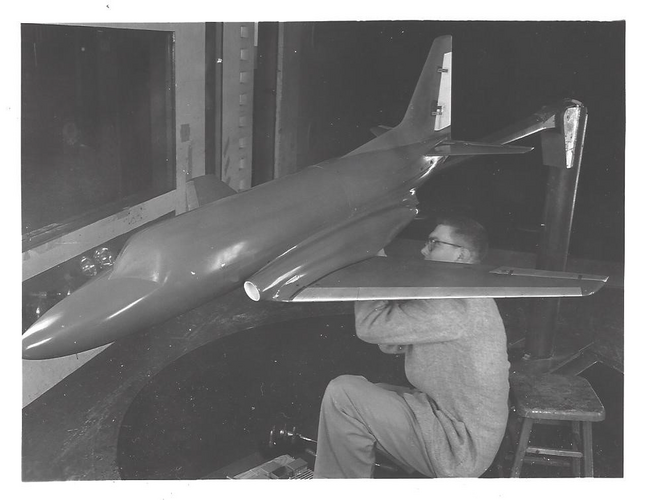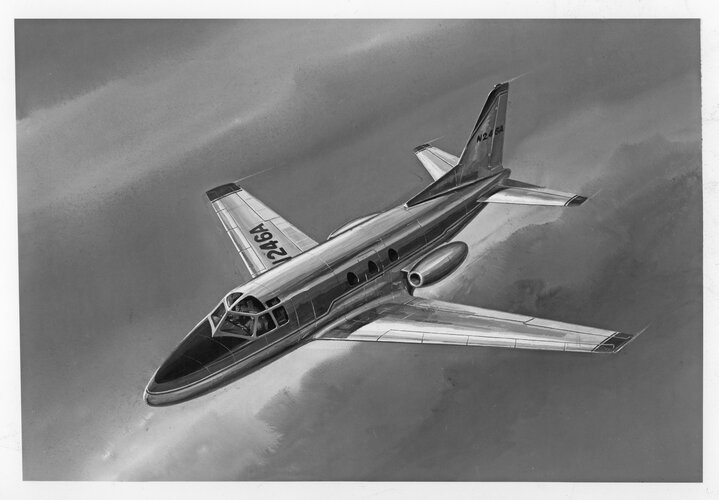- Joined
- 27 December 2005
- Messages
- 17,748
- Reaction score
- 26,407
North American Sabreliner & the F86 Sabre - Jack Trost
In the 1950s, the US Air Force issued a Request for Proposal under its Utility Trainer Experimental (UTX) program for a pilot proficiency trainer and utility transport aircraft. North American Aviation’s (NAA) response was to utilize the sweptwing, including leading edge slats and tail configuration, of their highly successful Korean War F86 fighter, and attach them to a passenger carrying cylindrical fuselage incorporating two jet engines positioned at the wing root.
As a newly-- graduated engineer at NAA, one of my first job assignments was to characterize the expected performance of this design. Wind tunnel tests were performed at the NAA lowspeed tunnel and the transonic Southern California Cooperative Wind Tunnel in Pasadena. A photograph of the sting mounted model is shown in the lowspeed tunnel. From these tests, I discovered two problems with the design. The aircraft was unstable at high angles of attack. That is to say, the forces on the model caused it to pitch up to higher angles as the airflow over the wings stalled. The other problem was the excessive drag at high-- of subsonic Mach numbers that would limit the maximum speed of the configuration.
In an attempt to solve the primary instability problem, I charted the flow field over the wing near the stall angle by sitting on the top of the opened panel of the tunnel test section using a long pole with a nylon tuft at the tip. I tried attaching flatplate fences and vortex generators in selected places on the wing to change the stall characteristics. Applying wax to sharpen the leading edge of the inboard wing profile did not improve the situation. In frustration, I reported to the chief aerodynamicist that my tricks did not work. Around that timeframe, the French Caravelle jet airliner landed for the first time at LAX. Its twin engines were mounted on the side of the fuselage aft of the wing. Relocating the Sabreliner engines from the wing root to the sides of the aft fuselage solved the instability problem.
Many years later, I read that the Sabreliner is the only business jet certified for aerobatics up to 3g. Schlieren photographs revealed that the excessive drag at high subsonic Mach numbers was caused by the onset of a normal shockwave at the forward top edge of the fuselage near the cockpit. Since the wind tunnel model was made of wood, we easily shaved this area down to lessen the sharp On another side curvature. The result of this physical change reduced the drag and moved the corner of the drag Mach number curve to 0.83 Mach number. This corresponds to a maximum speed of 478 knots at 40,000 feet which is the listed specification for the aircraft.
As a sidenote several years later, my former neighbor, a tall USAF Colonel, commented about his experience while flying the T39 Sabreliner: “I kept hitting my head on the ceiling of the cockpit. Why didn’t you design the cabin with more headroom?” My reply was: “Do you want more headroom or a higher cruise speed?”
note, also years later, while working for TRW and consulting to the USAF on the Ballistic Missile Program, I would periodically fly in one of the company’s three Sabreliners from LAX to Norton AFB in San Bernardino.
The Sabreliner prototype first flew in September 1958. The first example was delivered to the USAF in 1960 and it was the first of any business type jet aircraft to be delivered in the United States. Production ended in 1981 with over 800 aircraft built. Late in the production program, the wing was redesigned to incorporate a supercritical airfoil to reduce wave drag at transonic speeds.
Photos, from top: F86A Sabre in flight. (NAA Public Relations release)
Wind tunnel model of the original Sabreliner design configuration with the author checking instrumentation for testing. (Author's collection)
View of Sabreliner clearly showing swept wing (NAA Public Relations release)
From Supercruiser newsletter, Western Museum of Flight.
In the 1950s, the US Air Force issued a Request for Proposal under its Utility Trainer Experimental (UTX) program for a pilot proficiency trainer and utility transport aircraft. North American Aviation’s (NAA) response was to utilize the sweptwing, including leading edge slats and tail configuration, of their highly successful Korean War F86 fighter, and attach them to a passenger carrying cylindrical fuselage incorporating two jet engines positioned at the wing root.
As a newly-- graduated engineer at NAA, one of my first job assignments was to characterize the expected performance of this design. Wind tunnel tests were performed at the NAA lowspeed tunnel and the transonic Southern California Cooperative Wind Tunnel in Pasadena. A photograph of the sting mounted model is shown in the lowspeed tunnel. From these tests, I discovered two problems with the design. The aircraft was unstable at high angles of attack. That is to say, the forces on the model caused it to pitch up to higher angles as the airflow over the wings stalled. The other problem was the excessive drag at high-- of subsonic Mach numbers that would limit the maximum speed of the configuration.
In an attempt to solve the primary instability problem, I charted the flow field over the wing near the stall angle by sitting on the top of the opened panel of the tunnel test section using a long pole with a nylon tuft at the tip. I tried attaching flatplate fences and vortex generators in selected places on the wing to change the stall characteristics. Applying wax to sharpen the leading edge of the inboard wing profile did not improve the situation. In frustration, I reported to the chief aerodynamicist that my tricks did not work. Around that timeframe, the French Caravelle jet airliner landed for the first time at LAX. Its twin engines were mounted on the side of the fuselage aft of the wing. Relocating the Sabreliner engines from the wing root to the sides of the aft fuselage solved the instability problem.
Many years later, I read that the Sabreliner is the only business jet certified for aerobatics up to 3g. Schlieren photographs revealed that the excessive drag at high subsonic Mach numbers was caused by the onset of a normal shockwave at the forward top edge of the fuselage near the cockpit. Since the wind tunnel model was made of wood, we easily shaved this area down to lessen the sharp On another side curvature. The result of this physical change reduced the drag and moved the corner of the drag Mach number curve to 0.83 Mach number. This corresponds to a maximum speed of 478 knots at 40,000 feet which is the listed specification for the aircraft.
As a sidenote several years later, my former neighbor, a tall USAF Colonel, commented about his experience while flying the T39 Sabreliner: “I kept hitting my head on the ceiling of the cockpit. Why didn’t you design the cabin with more headroom?” My reply was: “Do you want more headroom or a higher cruise speed?”
note, also years later, while working for TRW and consulting to the USAF on the Ballistic Missile Program, I would periodically fly in one of the company’s three Sabreliners from LAX to Norton AFB in San Bernardino.
The Sabreliner prototype first flew in September 1958. The first example was delivered to the USAF in 1960 and it was the first of any business type jet aircraft to be delivered in the United States. Production ended in 1981 with over 800 aircraft built. Late in the production program, the wing was redesigned to incorporate a supercritical airfoil to reduce wave drag at transonic speeds.
Photos, from top: F86A Sabre in flight. (NAA Public Relations release)
Wind tunnel model of the original Sabreliner design configuration with the author checking instrumentation for testing. (Author's collection)
View of Sabreliner clearly showing swept wing (NAA Public Relations release)
From Supercruiser newsletter, Western Museum of Flight.


